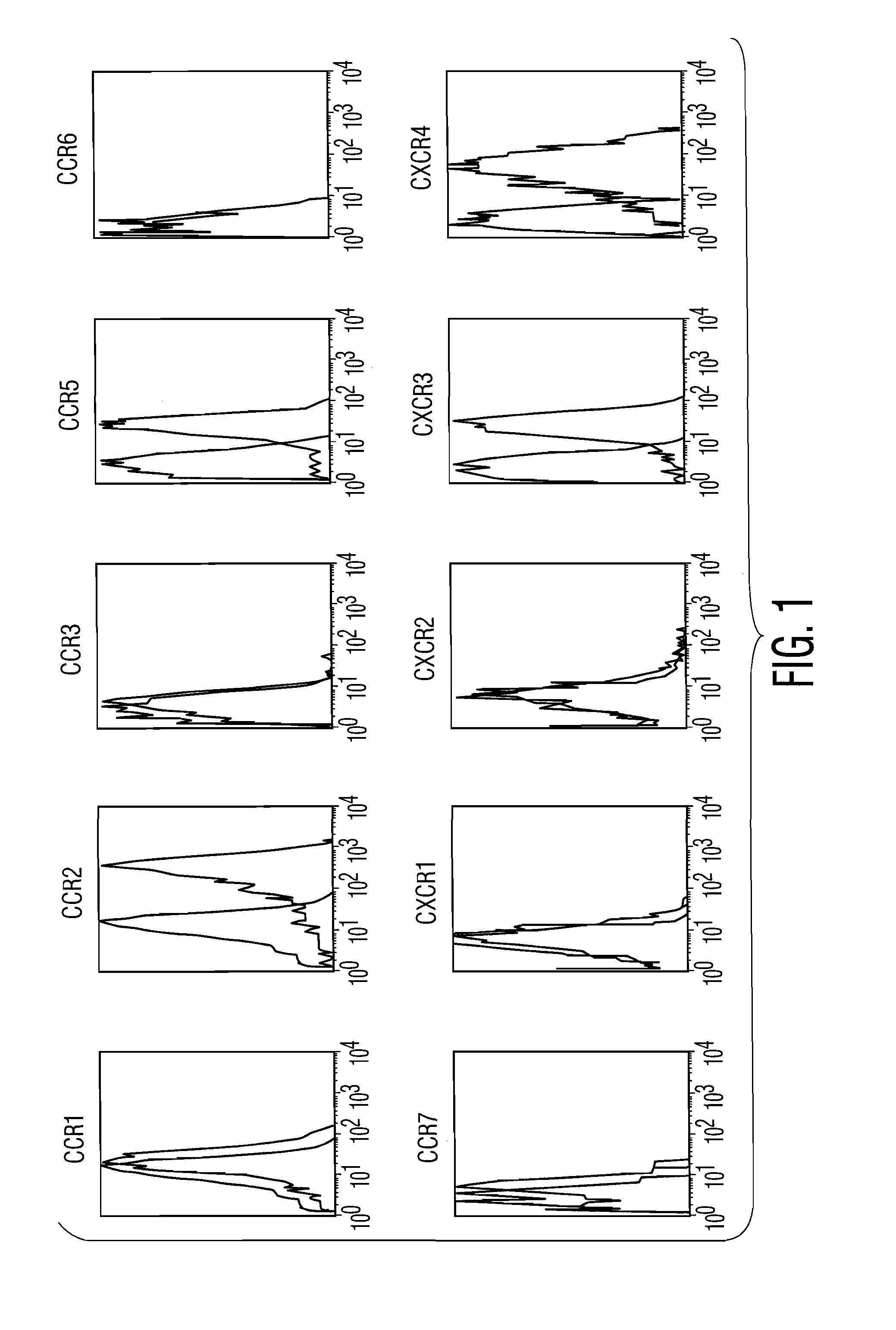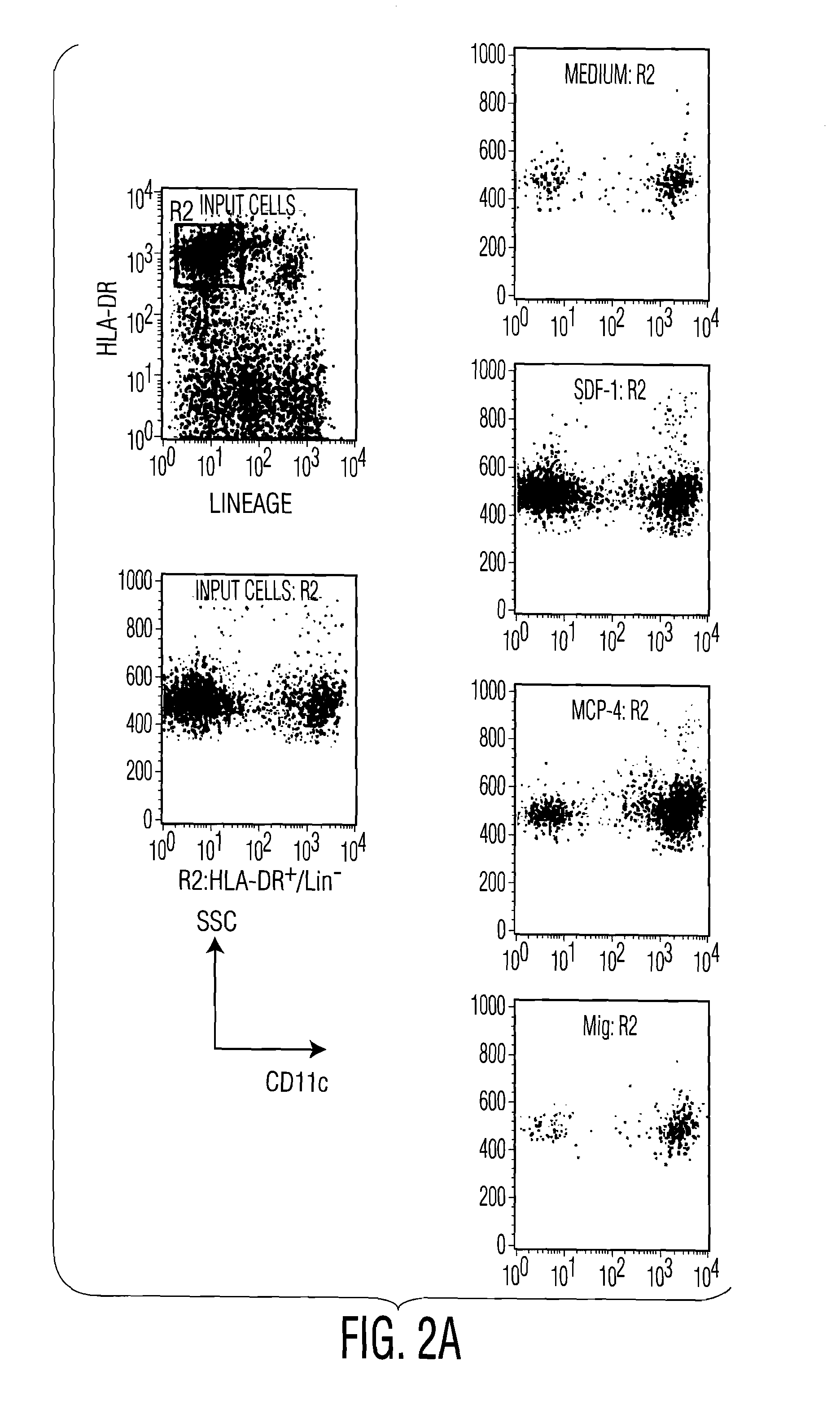Chemokines as adjuvants of immune response
a technology of chemokines and adjuvants, applied in the field of human chemokine receptor agonists and antagonists, can solve the problems of complex signals which regulate the trafficking of dendritic cells, are not fully understood, and little information is available regarding the migratory capacity of plasmacytoid dendritic cells
- Summary
- Abstract
- Description
- Claims
- Application Information
AI Technical Summary
Benefits of technology
Problems solved by technology
Method used
Image
Examples
example 1
Despite Expression of Receptors for Inflammatory Chemokines, Plasmacytoid DC Respond to the Constitutive Chemokine SDF-1
[0105]pDC were enriched from PBMC by magnetic beads depletion. Chemokine receptor and other marker expression was determined by triple staining on enriched blood DC populations and gating on Lin−, CD11c− (FITC), HLA-DR+ (tricolor), using PE-coupled antibodies. Following this protocol, the CD11c− pDC were 95-98% CD45RA+ and IL-3Rα+. pDC expressed CCR2 and CCR5 (FIG. 1) at a comparable levels to CD11c+circulating blood DC (Vanbervliet et al., 2001, Eur J Immunol. 32(1):231-42). CCR1, CCR3, CCR4, CCR6, CCR7, CXCR1, CXCR2, CXCR5 were not significantly expressed as detected by cytofluorimetry (FIG. 1) and / or RT-PCR.
[0106]To determine migration of pDC in response to various chemokines, circulating blood DC subsets were enriched by magnetic bead depletion. After purification, cells were rested for 2 hours at 37° C. and studied in transwell (5 μm pore size) migration assay...
example 2
Plasmacytoid DC Express High Levels of CXCR3 Compared to Other DC Populations
[0110]For blood CD11c− pDC, chemokine receptor and other marker expression was determined by triple staining on enriched blood DC populations and gating on Lin−, CD11c− (FITC), HLA-DR+ (tricolor), using PE-coupled antibodies. Following this protocol the CD11c− pDC were 95-98% CD45RA+ and IL-3Rα+.
[0111]For blood CD11c+ myeloid DC, chemokine receptor and other marker was determined by triple staining gated on Lin−, CD45RA− (FITC), HLA-DR+ (tricolor), using PE-coupled antibodies. Following this protocol the CD11c+myeloid DC were 95-98% CD11c+, IL-3Rα−.
[0112]CD34-derived DC or Monocyte-derived DC were processed for double staining using FITC-conjugated CD1a or CD14 and PE-conjugated monoclonal antibodies against human chemokine receptors.
[0113]As shown in FIG. 1, pDC expressed high levels of CXCR3 at cell surface. In contrast, circulating CD11c+blood DC, as well as other DC populations, did not express signific...
example 3
CXCR3 Ligands Synergize with SDF-1 to Induce Potent Migration of pDC
[0116]Migration assays were performed in response to different SDF-1 and CXCR3 ligand combinations.
[0117]As shows in FIG. 5, in presence of sub-optimal dose of SDF-1 (10 ng / ml) the activity of all 3 CXCR3-ligands was observed at lower concentration (100-500 ng / ml) (FIG. 5B). In addition, when tested in combination with SDF-1, all 3 CXCR3-ligands allowed to lower the threshold of SDF-1 sensitivity by 2 order of magnitude.
PUM
| Property | Measurement | Unit |
|---|---|---|
| concentrations | aaaaa | aaaaa |
| time | aaaaa | aaaaa |
| concentration | aaaaa | aaaaa |
Abstract
Description
Claims
Application Information
 Login to View More
Login to View More - R&D
- Intellectual Property
- Life Sciences
- Materials
- Tech Scout
- Unparalleled Data Quality
- Higher Quality Content
- 60% Fewer Hallucinations
Browse by: Latest US Patents, China's latest patents, Technical Efficacy Thesaurus, Application Domain, Technology Topic, Popular Technical Reports.
© 2025 PatSnap. All rights reserved.Legal|Privacy policy|Modern Slavery Act Transparency Statement|Sitemap|About US| Contact US: help@patsnap.com



